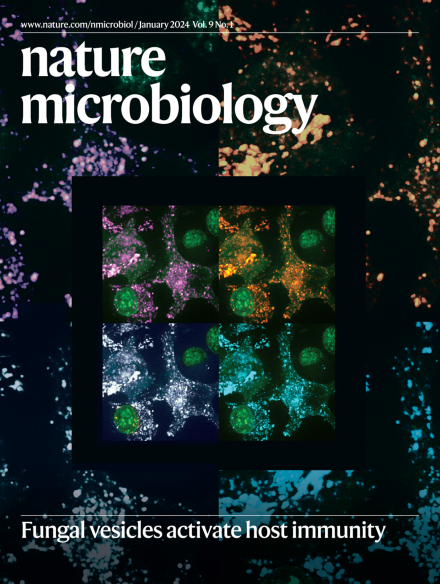Viruses and virus satellites of haloarchaea and their nanosized DPANN symbionts reveal intricate nested interactions.
IF 19.4
1区 生物学
Q1 MICROBIOLOGY
引用次数: 0
Abstract
Nested symbioses, including hyperparasitism in which parasites exploit other parasites within a host, are common in nature. However, such nested interactions remain poorly studied in archaea. Here we characterize this phenomenon in ultra-small archaea of the candidate phylum Nanohaloarchaeota, members of the DPANN superphylum (named after its first representative phyla: Diapherotrites, Parvarchaeota, Aenigmarchaeota, Nanoarchaeota and Nanohaloarchaeota) that form obligate interactions with halophilic archaea of the class Halobacteria. We reconstructed the viromes from geothermally influenced salt lakes in the Danakil Depression, Ethiopia, and find that nanohaloarchaea and haloarchaea are both associated with head-tailed, tailless icosahedral, pleomorphic and spindle-shaped viruses, representing 16 different families. These viruses exhibit convergent adaptation to hypersaline environments, encode diverse auxiliary metabolic genes and exchange genes horizontally with each other. We further characterize plasmid-derived satellites that independently evolved to parasitize spindle-shaped viruses of haloarchaea and nanohaloarchaea, revealing another layer of nested symbiosis. Collectively, our findings highlight the complexity of virus-host and virus-virus interactions in hypersaline environments.盐古菌的病毒和病毒卫星及其纳米级的DPANN共生体揭示了复杂的嵌套相互作用。
巢式共生,包括寄生虫利用宿主内其他寄生虫的超寄生,在自然界中很常见。然而,这种嵌套的相互作用在古细菌中仍然很少被研究。在这里,我们在候选门Nanohaloarchaeota的超小型古细菌中描述了这种现象,该门是DPANN超门的成员(以其第一个代表门命名:Diapherotrites, Parvarchaeota, Aenigmarchaeota, Nanoarchaeota和Nanohaloarchaeota),它们与嗜盐古细菌类形成专性相互作用。我们重建了埃塞俄比亚达纳基尔洼地受地热影响的盐湖的病毒组,发现纳米盐古菌和盐古菌都与头尾、无尾二十面体、多形性和纺锤形病毒有关,代表了16个不同的科。这些病毒表现出对高盐环境的趋同适应,编码多种辅助代谢基因,并相互水平交换基因。我们进一步描述了质粒衍生的卫星,它们独立进化,寄生于盐古菌和纳米盐古菌的纺锤状病毒,揭示了另一层嵌套共生。总的来说,我们的发现强调了高盐环境中病毒-宿主和病毒-病毒相互作用的复杂性。
本文章由计算机程序翻译,如有差异,请以英文原文为准。
求助全文
约1分钟内获得全文
求助全文
来源期刊

Nature Microbiology
Immunology and Microbiology-Microbiology
CiteScore
44.40
自引率
1.10%
发文量
226
期刊介绍:
Nature Microbiology aims to cover a comprehensive range of topics related to microorganisms. This includes:
Evolution: The journal is interested in exploring the evolutionary aspects of microorganisms. This may include research on their genetic diversity, adaptation, and speciation over time.
Physiology and cell biology: Nature Microbiology seeks to understand the functions and characteristics of microorganisms at the cellular and physiological levels. This may involve studying their metabolism, growth patterns, and cellular processes.
Interactions: The journal focuses on the interactions microorganisms have with each other, as well as their interactions with hosts or the environment. This encompasses investigations into microbial communities, symbiotic relationships, and microbial responses to different environments.
Societal significance: Nature Microbiology recognizes the societal impact of microorganisms and welcomes studies that explore their practical applications. This may include research on microbial diseases, biotechnology, or environmental remediation.
In summary, Nature Microbiology is interested in research related to the evolution, physiology and cell biology of microorganisms, their interactions, and their societal relevance.
 求助内容:
求助内容: 应助结果提醒方式:
应助结果提醒方式:


